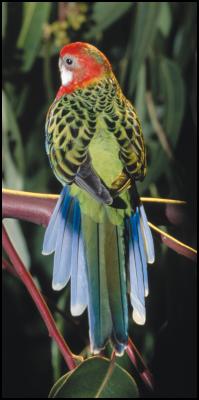Parrot promotion creates flurry of calls

Sightings of the Eastern Rosella flew in from all over the region.
Parrot promotion creates flurry
of calls
For immediate release: Wednesday 17 August
2005
“Have you seen this parrot?”
When Environment Bay of Plenty wanted to find out more about an Australian parrot that was damaging horticultural crops in the region, staff asked for help from local residents. And they got it.
Over a period of two weeks, more than 1000 people called a special number to report sightings of the distinctive Eastern Rosella.
“We were absolutely swamped,” admits pest animal coordinator David Moore. “We had no idea there were so many of these pest birds within the region, or that people would be so very helpful.”
Mr Moore launched the short, intensive promotion because he was receiving complaints of Eastern Rosella damaging fruit crops. The parrots can also carry diseases that are a potential threat to our native parrots, such as kakariki and kea.
“We’d heard lots of stories but had no verified information. We didn’t have any real idea of how many were out there or how big the problem might be.”
Now, of course, he has “a massive amount” of data on their distribution and numbers. The information will now be checked for duplicate sightings. After that, locations will be plotted on a regional map, along with the numbers in each area.
The next step, in association with Massey University, will be to test a sample of eastern rosellas for beak and feather disease. The results will help determine what follows. “We will be looking at options, and one of them may be some form of control.”
Eastern Rosellas (Platycerus eximius) are Australian parrots that first established in Dunedin around 1910. They are larger and much more colourful than native parakeet, with an average size of 330mm. The birds feed on a wide range of seeds, berries, fruits and blossoms.
The Eastern Rosella is listed as a surveillance pest animal in Environment Bay of Plenty’s regional pest management strategy.
ENDS


 Gordon Campbell: On The Hikoi Aftermath
Gordon Campbell: On The Hikoi Aftermath Stats NZ: National Population Estimates: At 30 September 2024 (2018-base)
Stats NZ: National Population Estimates: At 30 September 2024 (2018-base) NZ Government: New Zealand’s COP29 National Statement
NZ Government: New Zealand’s COP29 National Statement Surf Life Saving NZ: Volunteer Lifeguards Make Big Effort To Keep Us Safe, As Paid Lifeguard Service Commences In Northern Region
Surf Life Saving NZ: Volunteer Lifeguards Make Big Effort To Keep Us Safe, As Paid Lifeguard Service Commences In Northern Region Action Station: Biggest Ever Community Petition, With Over 200,000 Signatures, Opposes Treaty Principles Bill
Action Station: Biggest Ever Community Petition, With Over 200,000 Signatures, Opposes Treaty Principles Bill Palestinians for Hīkoi mō te Tiriti: Statement From Palestinian Leaders - Hīkoi Mō Te Tiriti Is A Historic Moment For All In Aotearoa
Palestinians for Hīkoi mō te Tiriti: Statement From Palestinian Leaders - Hīkoi Mō Te Tiriti Is A Historic Moment For All In Aotearoa Anglican Church in Aotearoa: Anglican Archbishops To Join Hīkoi Mō Te Tiriti In Wellington
Anglican Church in Aotearoa: Anglican Archbishops To Join Hīkoi Mō Te Tiriti In Wellington


